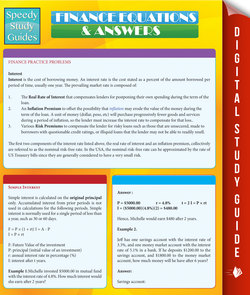Читать книгу Finance Equations & Answers (Speedy Study Guides) - Speedy Publishing - Страница 2
ОглавлениеFINANCE PRACTICE PROBLEMS
Interest
Interest is the cost of borrowing money. An interest rate is the cost stated as a percent of the amount borrowed per period of time, usually one year. The prevailing market rate is composed of:
1.The Real Rate of Interest that compensates lenders for postponing their own spending during the term
of the loan.
2.An Inflation Premium to offset the possibility that inflation may erode the value of the money during the term of the loan. A unit of money (dollar, peso, etc) will purchase progressively fewer goods and services during a period of inflation, so the lender must increase the interest rate to compensate for that loss..
3.Various Risk Premiums to compensate the lender for risky loans such as those that are unsecured, made to borrowers with questionable credit ratings, or illiquid loans that the lender may not be able to readily resell.
The first two components of the interest rate listed above, the real rate of interest and an inflation premium, collectively are referred to as the nominal risk-free rate. In the USA, the nominal risk-free rate can be approximated by the rate of US Treasury bills since they are generally considered to have a very small risk.
SIMPLE INTEREST
Simple interest is calculated on the original principal only. Accumulated interest from prior periods is not used in calculations for the following periods. Simple interest is normally used for a single period of less than a year, such as 30 or 60 days.
F = P × (1 + rt) I = A - P
I = P × rt
F: Future Value of the investment
P: principal (initial value of an investment)
r: annual interest rate in percentage (%)
I: interest after t years.
Example 1: Michelle invested $5000.00 in mutual fund with the interest rate of 4.8%. How much interest would she earn after 2 years?
Answer :
P = $5000.00 r = 4.8% t = 2 I = P × rt
I = ($5000.00)(4.8%)(2) = $480.00
Hence, Michelle would earn $480 after 2 years.
Example 2.
Jeff has one savings account with the interest rate of 3.3%, and one money market account with the interest rate of 5.1% in a bank. If he deposits $1200.00 to the savings account, and $1800.00 to the money market account, how much money will he have after 6 years?
Answer:
Savings account:
